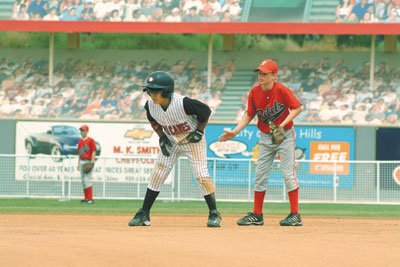Gilroy
– Hundreds of Little League ballplayers are now digging their
cleats into the same red clay found at major league stadiums. Soon,
they may have a chance to swat home runs over Wrigley Field’s
ivy-covered brick wall or Fenway Park’s Green Monster – all without
leaving Gilroy.
Gilroy – Hundreds of Little League ballplayers are now digging their cleats into the same red clay found at major league stadiums. Soon, they may have a chance to swat home runs over Wrigley Field’s ivy-covered brick wall or Fenway Park’s Green Monster – all without leaving Gilroy.
Big League Dreams, a national recreation company that specializes in operating life-like replicas of famous ball stadiums, is in talks with City Hall about the possibility of constructing a facility in south Gilroy, at the site of the newly opened sports complex.
“It’s just unbelievable what this company has done,” said Councilman Dion Bracco, who suggested to council members last month that the city sign a deal with Big League Dreams. “They go in with a public-private partnership. They build (the park), they manage it, they would even take over our softball programs for us. The burden is off the city. They just basically write us a check.”
Though the deal sounds like a no-brainer, officials are cautiously weighing the pros and cons. In coming weeks, city staff will present council with a study of how much it would cost to build the park, compared to revenues and savings from handing over its operation to Big League Dreams. Though the company helps design the park and oversees construction, the city must front the money.
“From a staff point of view, what we want to know is are we even in the ball game?” City Administrator Jay Baksa said. “Are we within some sort of scope to be able to consider this? If it comes back and the revenue is so little and the cost avoidance is so little that it doesn’t cover the debt payments, we may not be able to do this.”
Big League Dreams has constructed parks in Chino Hills and Redding for about $14 million each – a few million more than the cities had budgeted for more traditional sports parks, according to Pat Kight, a consultant for the company.
Kight served as mayor of Redding when the project passed through the city’s regulatory process, and ultimately ended up working for the company.
“When I was with the city of Redding in 2005, the city had fewer than 45 adult softball teams,” he said. “Last summer, (the city) had 239 teams.”
The city of Redding conducted an economic impact report that showed the park has attracted $16 million in new tourism revenues. Similar successes have been seen in leagues outside Houston, which expects to have more than 300 teams after a year in operation, and in Chino Hills, which has 490 teams after four years of operation.
“Manteca park opened in October, and they’ll probably have 250 teams playing there this spring,” Kight said.
The company’s formula for success involves a core business of youth baseball and adult softball, combined with revenues from a family-style restaurant, business advertising and corporate events. Each park is constructed in a similar fashion, with the fields arranged in a “wheel” around the restaurant, perched at the center of the wheel overlooking each the outfield walls. The walls range from 18 to 30 feet high and use computer-generated graphics to replicate the look and feel of famous ballparks, including Yankee Stadium.
In addition to batting cages for ball players, the company also builds pavilions for roller hockey, soccer and other indoor sports.
While a liquor license helps its restaurants attract corporate clients and weddings, alcohol is not served during youth events, Kight said, who called weekend tournaments “huge” for local hotels, restaurants and shopping centers.
A third of Gilroy’s tax base comes from the Gilroy Premium Outlets and big box stores east of U.S. 101, and the prospect of a tourism windfall from a park that pays for itself is alluring to city officials.
“If this is as good as I think it’s going to be, I would really like to see it moved on fast,” Bracco said.
Other cities in the region are courting the company, Kight said, but he would not name them.
If the city moves forward on the deal, residents could see the next major phase of an 80-acre sports complex completed years earlier than expected. The city’s Little League teams started practicing two weeks ago at the complex, unveiled in October. Boys and girls from nearly 100 youth teams will gather March 17 at the park for season opening ceremonies.
Christine Drysdale, president of Gilroy Little League, said three ball fields are a good start, but she’s thrilled by the prospect of Big League Dreams.
“It’s a way different level,” Drysdale said. “They have turf and they have the walls. It’s way, way more sophisticated than what we have. I think it would be great for Gilroy, because they will get it up and running a lot faster than the city would be able to do. They have a good reputation and they’ve been around a long time. Not just that, but tournaments would bring so many people to stay in our hotels and eat in our restaurants. I can’t see any negatives.”














